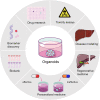Organoids: The current status and biomedical applications
- PMID: 37215622
- PMCID: PMC10192887
- DOI: 10.1002/mco2.274
Organoids: The current status and biomedical applications
Abstract
Organoids are three-dimensional (3D) miniaturized versions of organs or tissues that are derived from cells with stem potential and can self-organize and differentiate into 3D cell masses, recapitulating the morphology and functions of their in vivo counterparts. Organoid culture is an emerging 3D culture technology, and organoids derived from various organs and tissues, such as the brain, lung, heart, liver, and kidney, have been generated. Compared with traditional bidimensional culture, organoid culture systems have the unique advantage of conserving parental gene expression and mutation characteristics, as well as long-term maintenance of the function and biological characteristics of the parental cells in vitro. All these features of organoids open up new opportunities for drug discovery, large-scale drug screening, and precision medicine. Another major application of organoids is disease modeling, and especially various hereditary diseases that are difficult to model in vitro have been modeled with organoids by combining genome editing technologies. Herein, we introduce the development and current advances in the organoid technology field. We focus on the applications of organoids in basic biology and clinical research, and also highlight their limitations and future perspectives. We hope that this review can provide a valuable reference for the developments and applications of organoids.
Keywords: 3D culture; drug screening; precision medicine; stem cells; tumoroid.
© 2023 The Authors. MedComm published by Sichuan International Medical Exchange & Promotion Association (SCIMEA) and John Wiley & Sons Australia, Ltd.
Conflict of interest statement
The authors have no conflicts of interest to disclose.
Figures




References
-
- Rheinwald JG, Green H. Serial cultivation of strains of human epidermal keratinocytes: the formation of keratinizing colonies from single cells. Cell. 1975;6(3):331‐343. - PubMed
-
- Yu J, Vodyanik MA, Smuga‐Otto K, et al. Induced pluripotent stem cell lines derived from human somatic cells. Science. 2007;318(5858):1917‐1920. - PubMed
-
- Sato T, Vries RG, Snippert HJ, et al. Single Lgr5 stem cells build crypt‐villus structures in vitro without a mesenchymal niche. Nature. 2009;459(7244):262‐265. - PubMed
-
- Altinisik N, Rathinam D, Tran M, Gopalakrishnan J. Brain organoids restore cortical damage. Cell Stem Cell. 2023;30(3):241‐242. - PubMed
Publication types
LinkOut - more resources
Full Text Sources
